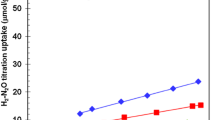Abstract
Experiments were performed with temperature programmed desorption of hydrogen and deuterium adsorbates on small platinum spheres. Beyond the expected desorption peak of these adsorbates at around 300 K sample temperature an additional desorption peak at higher temperatures was observed. This additional peak is explained by the diffusion of hydrogen or deuterium atoms from the inside of the spheres to their surfaces with final desorption from these surfaces. The visibility of this second high temperature desorption peak is supported by a small diameter of the platinum spheres. Platinum spheres with diameters around 64 μm were used. The sample temperature at which the second peak was observed depends on the parameters: diameter of the platinum spheres, heating rate of the sample and chemical diffusion coefficient of hydrogen or deuterium in platinum. A theory, which assumes that the chemical diffusion coefficient can be described with an Arrhenius ansatz, was developed to simulate the occurrence of the second peak. The combination of these kinds of experiments with the theory gives a method to measure chemical diffusion coefficients. This method can be called temperature programmed diffusion. At 510 K sample temperature the diffusion coefficient 1.61×10−12 m2/s of hydrogen in platinum and the diffusion coefficient 1.40×10−12 m2/s of deuterium in platinum was measured.
Similar content being viewed by others
References
P.A. Redhead, Vacuum 12, 203 (1962)
C. Krishana, S.J. Qi, J.A. Incavo, W.L. Reuter, V. Jain, U.S. Patent, 5,627,329 (1995)
Y. Ebisuzaki, W.J. Kass, M. O’Keeffe, J. Chem. Phys. 49, 3329 (1968)
H. Katsuta, R.B. McLellan, J. Phys. Chem. Solids 40, 697 (1979)
E. Gileadi, M.A. Fullenwider, J.O’M. Bockris, J. Electrochem. Soc. 113, 926 (1966)
T. Ishikawa, R.B. McLellan, Acta Metall. 33, 1979 (1985)
J. Čermák, A. Kufudakis, G. Gardavská, J. Less-Common Met. 63, P1 (1979)
H. Ibach, Physics of Surfaces and Interfaces (Springer, Berlin, Heidelberg, 2006), p. 273
F.J. Castro, G. Meyer, Rev. Sci. Instrum. 71, 2131 (2000)
F. von Zeppelin, M. Haluška, M. Hirscher, Thermochim. Acta 404, 251 (2003)
R. Ducros, R.P. Merrill, Surf. Sci. 55, 227 (1976)
H.S. Carlslaw, J.C. Jaeger, Conduction of Heat in Solids (Clarendon Press, Oxford, 1959), p. 234
K. Christmann, G. Ertel, Surf. Sci. 60, 365 (1976)
K. Christmann, private communication (2010)
C. Zener, J. Appl. Phys. 22, 372 (1951)
A.M. Baró, H. Ibach, H.D. Bruchmann, Surf. Sci. 88, 384 (1979)
S. Hong, T.S. Rahman, R. Heid, K.P. Bohnen, Surf. Sci. 587, 41 (2005)
Author information
Authors and Affiliations
Corresponding author
Rights and permissions
About this article
Cite this article
Neuhaus, D. Method for measuring chemical diffusion coefficients in solids. Appl. Phys. A 100, 991–1000 (2010). https://doi.org/10.1007/s00339-010-5956-x
Received:
Accepted:
Published:
Issue Date:
DOI: https://doi.org/10.1007/s00339-010-5956-x




